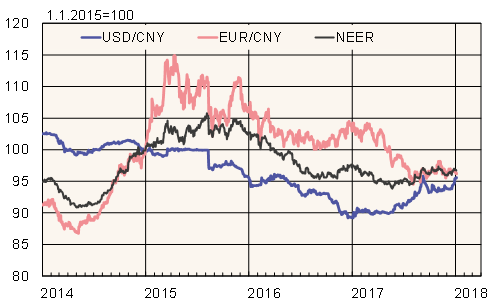BOFIT Weekly Review 01/2018
Yuan strengthened against the dollar and weakened against the euro in 2017
Depreciation pressures on the yuan increased in the wake of the August 2015 mini devaluation, with the yuan-dollar exchange rate weakening through late 2016. To halt the yuan's slide and stem capital outflows, China cracked down on capital exports and stabilised the yuan's external value. In 2017, the yuan gained 6.7 % against the dollar, weakened 6.2 % against the euro, and remained fairly stable against a basket of currencies of China's main trading partners (nominal effective exchange rate or NEER). The yuan's appreciation against the dollar reflected the general weakness of the dollar against other currencies. The stability of the yuan's real effective exchange rate (REER) suggests that there was little change in China's price competitiveness in 2016. On Thursday (Jan. 4), one dollar bought 6.49 yuan and one euro 7.84 yuan.
Yuan exchange rate vis-à-vis the US dollar, euro and a weighted basket of currencies of China's main trading partners (NEER)

Sources: Reuters, J.P. Morgan, BOFIT.